The Best Product Review Template to Follow in 2024
Note: This article has been updated to reflect the three Google Product Reviews Updates, which were rolled out over the course of 2021 and 2022.
While the advice remains virtually the same, I've also highlighted key recommendations that align with Google's new recommendations. You can find these highlighted in boxes like this one.
According to a 2020 survey, 91% of 18-34 year olds trust online reviews as much as personal recommendations.
At Affilimate, our platform automatically tracks which elements on your site result in conversions across a ton of different affiliate networks and merchants.
This means, this product review template is based on real-world data about which visuals, CTAs, and copywriting techniques lead to better conversions across products and niches.
And we're here to share those insights with you today!
You can apply these techniques whether you're an editorial reviewer, affiliate marketer, or even just writing a sales page for your own product.
Stick around for real-world product review examples from affiliate sites and top publishers, specific screenshots, and tools you need to apply these exact techniques for yourself.
By the end, you'll be able to improve the conversion rate of your product reviews and test your changes in a systematic way.
What to include in a product review template
Here's an outline of our product review template, which will work for products on Amazon or any other merchant.
- Craft a title for your review that stands out
- Establish authority as a reviewer
- Include a product review summary
- Include a buying guide for the product (And its category)
- Share your results (Images, Screenshots, Social Proof)
- List product alternatives
- Conclude with a strong CTA
It doesn't matter if you're using WordPress or another site-builder for your product review, all the techniques can be created with minimal code or tech changes on your website.
You'll be surprised at how simple the copywriting, design, and images can be in a really good product review that reliably converts. We'll cover each aspect step-by-step:

While the exact order isn't gospel, each of these elements lends themselves to a high-converting review that's genuinely useful for readers (without sounding salsey or sleezy).
From top to bottom, let's start with the title.
1. Craft a title for your review that stands out
You don't have to write your title first, but you do have to spend time on it.
If you're targeting competitive buyer intent keywords with your product review, you want to have a title that both helps you rank and helps you stand out from the other search results.
There are a lot of ways to do this: You can use techniques like resorting to ALL CAPS or including the current year (2024) in every single title. But some of the most effective product review titles combine these methods with something that sparks interest.
For example, this review on Lucie's List ranks in the top 5 results for the Mercedes of baby strollers, UPPAbaby VISTA — a pram that'll put a $928-hole in your pocket.
This review stands out by declaring the V2 version of the stroller, "Better Than Ever".'

What important to remember is that your title and H1 tag don't need to match perfectly. So you're at liberty to write a more enticing headline for the SERPs, and a more precise one for on-page (or vice versa).
In this example, Lucie's List opts for a shorter, simple on-page headline.
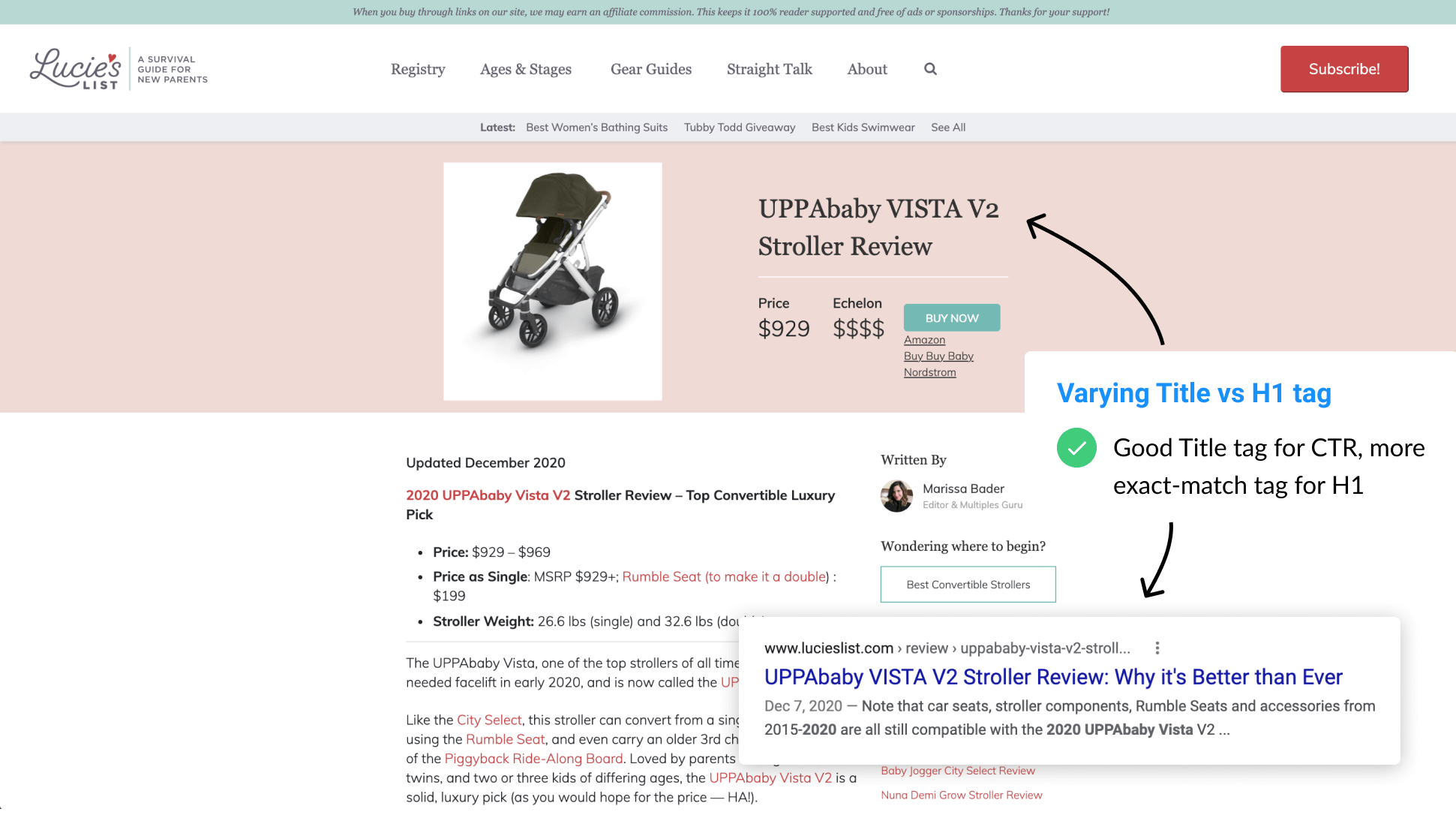
If most readers of your product reviews are coming from organic search, don't neglect starting off with a strong title and headline. Here are some product review titles you can use:
- "[Product Name] Review: Why It's Better Than Ever"
- "[Product Name] Review: Still Worth It in 2024?"
- "[Product Name] Review: An Honest Look"
- "[Product Name] Review: The Best [Product Category] for [Persona]"
2. Establish authority as a reviewer
After earning your click, the next task for a reviewer is to establish authority. Or at least explain to the reader, "Here's why you should listen to me."
Sounding like a nameless, faceless, AI-powered content robot will not make you look more professional. On the contrary, it can turn people off from trusting what you have to say.
This is in line with the guidelines from Google's Product Review update:
"The overall focus is on providing users with content that provides insightful analysis and original research, and is written by experts or enthusiasts who know the topic well."
Here's a concrete example of how The Points Guy establishes its authority at the beginning of a review about the black Amex card:

The author uses his own photo, points to exclusive "sources" on the benefits, and even reveals that the founder of has a similar card himself. I mean, if The Points Guy uses it, it has to be a winner.
This is where it's also important to be relatable to the reader. Whether you've been on the same buying journey as them before, tried a ton of products in the category to find your perfect match, or are a subject matter expert who can demistify confusing terminology.
They want to know that you've been where they are now, and you empathize with their situation.
You'll find a section with a similar function on literally every review by Wirecutter. This one declares, "Lauren has probably evaluated more headphones than anyone on earth."
Not only does it establish authority, but it signals, "You don't need to look anywhere else."

As we'll see in the next section, Wirecutter both establishes trust early on by introducing their expert reviewers and talking about their review and testing process.
But not far into the peice, they also allude to the professional qualifications of the authors.
In short, trust is critical. Especially if readers are landing on your website for the first time and don't have a history with your brand or with the product itself.
Here are key ways to establish authority in a product review:
- Identify yourself as the author early in the piece
- Use a picture of yourself, especially with or using the product (or screenshots)
- Make jokes, be self-deprecating, get readers to like you!
- Explain why you're an expert on the topic and qualified to make the review
- Empathize with the pain points readers are probably coming to you with
- Address those concerns directly, without being overly positive or salsey
- Have a clean website design and basic, memorable branding
From here, you want to give the hit-and-run readers the gist.
3. Include a product review summary
This article is over 3,000 words but in reality, you'll probably only read a few hundred of it. That's just the state of reading on the internet today — most people want to get the gist.
The absolute fewest facts needed to buy or skip on the product.
You can optimize your click-through rate (and ultimately conversions) by including a summary of the product early in the post for the skimmers.
A good product review summary should clearly answer these key questions:
- Do you personally recommend this product?
- Who is this product best for (e.g. travelers, new parents, tall people, etc)?
- Where can the product be purchased? At the best price?
These summaries are a staple of Wirecutter's reviews.

Before losing any readers to the Back button, they are intentional about establishing authority, introducing the reviewers, and giving you the "quick take" of which product they think is best and why.
In the most compact amount of screen real estate.
Importantly, they also address key concerns: does the reviewer like the product, is it product a fit for me, and where am I going to get the best deal?
A product review summary is useful not only in straight up product reviews, but also in product comparisons and product category roundups. For example, in this article comparing VPNs:
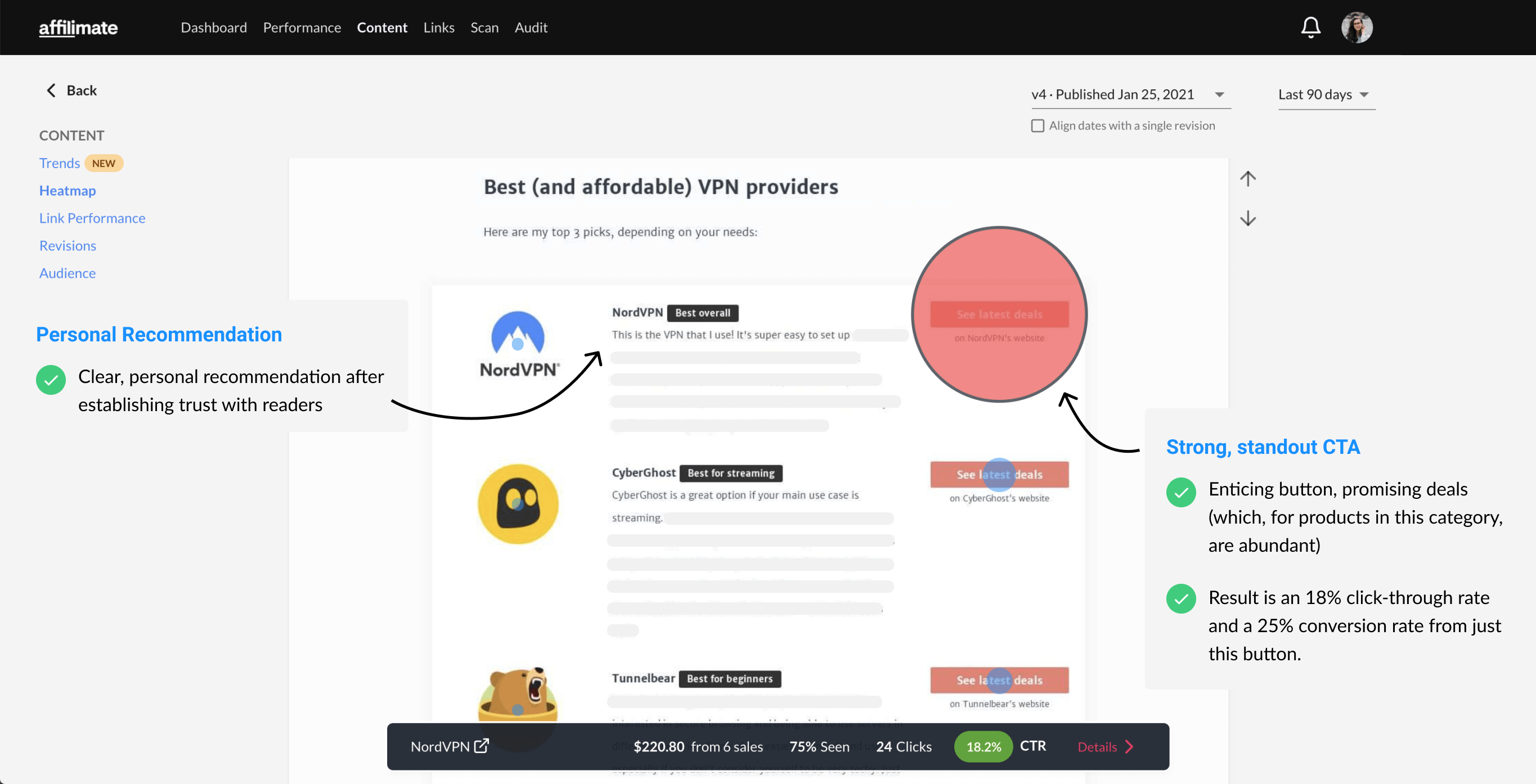
Thanks to Affilimate, I know that my product summary table is the exact place on the article that's converting. Trust-building content, followed by a single, well-placed button and the right copy converts at a rate of 25%.
Some of the most popular and effective CTAs include:
- Check availability
- Check current prices
- See latest deals
- See it
In a final example, this review by Outdoor Gear Lab compares women's running shoes in a 7,400-word article. But you don't need to read the whole thing to know which one the editor prefers.

Your intuition might say that you want to be able to "sell" the reader on the product with more copy before making that buy button available.
But both our data at Affilimate and the practices followed by leading publishers pave the way to the same conclusion:
Proceeded by trust-building copy, your first links are usually the most lucrative.
But, there are always people who need more information. That's where the actual review and buying guide come in.
4. Include a buying guide for the product (And its category)
Now comes the product review itself. Here you'll want to include all the information the reader expects: materials, tech specs, quality, durability, value for money, and everything else that matters to consumers.
And depending on the complexity of the product category, and whether your reader is likely to be a first-time buyer, you may also want to include a buying guide.
Here's how to write both.
What to put in a product review
Ultimately, you want to make sure that everything important to the reader is covered in your article. Here are some of the most important, do-not-miss aspects to include in your review.
- Identify who the product is for. These could be personas, market segments, demographics, you name it. You want to make it easy for people to identify that the product is right for them.
- Include relevant specs. Which specs matter for this product category? For example, with tents it might be the material and whether it's waterproof. Or with makeup, what the ingredients are.
- Talk about solutions you'd tried before. If you've tried alternative products, include them in your review and why they did or didn't work for you.
- Talk about the problems it solves for you. What issues did this product solve and how long have you been using it?
- Address shortcomings. Avoid painting an overly rosy picture — talk about the shortcomings and tradeoffs you had to make, and whether they pose a real problem for you.
- Answer FAQs. You can find tons of related questions (and pick up featured snippets and other SERP features) by looking at "People Also Ask" on Google, using Autocomplete, and checking existing FAQ rich results.
All of these recommendations are in line with those from Google's Product Review update:
For those creating content, here are some additional useful questions to consider in terms of product reviews. Do your reviews:
- Express expert knowledge about products where appropriate?
- Show what the product is like physically, or how it is used, with unique content beyond what’s provided by the manufacturer?
- Provide quantitative measurements about how a product measures up in various categories of performance?
- Explain what sets a product apart from its competitors?
- Cover comparable products to consider, or explain which products might be best for certain uses or circumstances?
- Discuss the benefits and drawbacks of a particular product, based on research into it?
- Describe how a product has evolved from previous models or releases to provide improvements, address issues, or otherwise help users in making a purchase decision?
- Identify key decision-making factors for the product's category and how the product performs in those areas? For example, a car review might determine that fuel economy, safety, and handling are key decision-making factors and rate performance in those areas.
- Describe key choices in how a product has been designed and their effect on the users beyond what the manufacturer says?
Let's look at a few examples.
To give an example of FAQs, these are great to include at the very end of your article. These FAQs help you answer any last objections or concerns, and capture featured snippet and FAQ rich results.
For example, Her Packing List is a huge review site for female travel gear. In their Kanken review, they answer questions about whether the backpack is waterproof, washable, and fits a laptop.
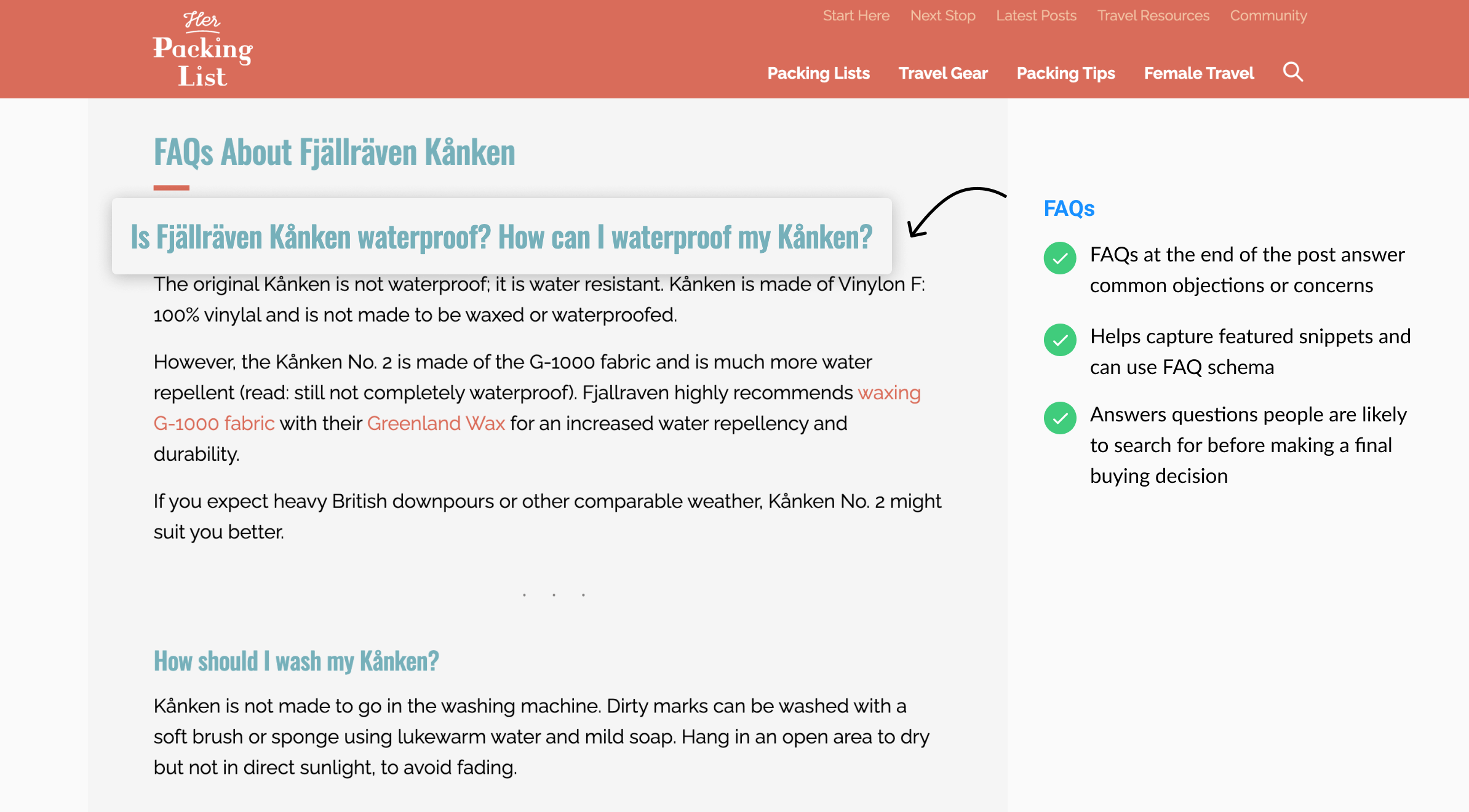
In general, one of the easiest ways to figure out what's important to readers (such as those decision-making factors mentioned by Google, or quantitative measurements you can collect for yourself) is to look at Amazon's sales pages and compare it to your product review.
For example, here's what Amazon's sales page for the Kindle Paperwhite looks like:

You can immediately see which key points Amazon wants to drive home: no glare, storage space, battery life, and ability to read outdoors.
All aspects you can then cover in your product review! Similarly, if you're doing a product roundup review, you can get inspiration from the comparison tables that Amazon includes on their product pages, too.
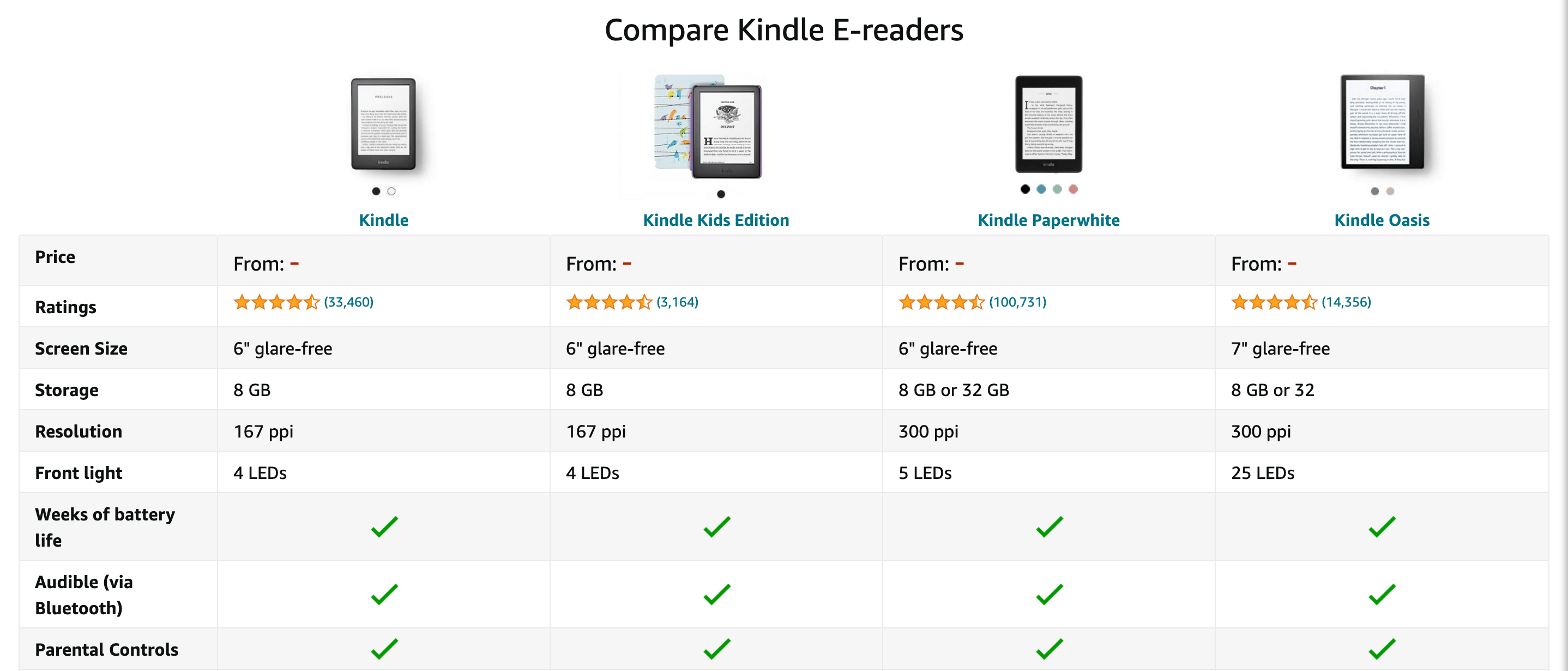
Price and ratings, screen size and battery life, storage, battery life, and so on.
Amazon isn't the only ecommerce retailer that has great sales pages you can learn from and use to adapt your product review template.
Don't forget to carefully check the product pages for the products you're promoting, you'll learn a lot about what's already converting for the merchant.
(Alternatively, if their product page is terrible, it's unlikely to convert and you might be wasting your time if you plan to promote it!)
Beyond the product itself, maybe you're writing for potential first-time buyers who are new to the product category.
At that point, it helps to include a basic buying guide.
What is a buying guide?
A buying guide is a resource that helps prospective customers understand which features and specifications products in a certain category have, why they matter, and how to pick a product that will work for them.
You don't need to place this early in your article, and it doesn't have to be long.
But a buying guide is a great way to double-down on your established authority while also priming readers to confidently make a decision once you reiterate your top picks.
For example, at the end of this article about Dyson vacuums, Wired lays out all the terminology.

Your buying guide should include:
- Your recommend product's features and benefits
- How products by this brand are named or distinguished from each other
- What to look for in a product in this category or brand
- Warning signs that tell you the product isn't for you
- Cheaper or more budget-friendly alternatives by the same brand
Beyond helping readers make a decision, it's also a way to pick up more keywords for your article — especially keywords where it doesn't make sense to write a dedicated article.
5. Share your results (Images, Screenshots, Social Proof)
Now comes the part I consider the most common mistake affiliates, marketers, and product creators make in their product reviews and sales pages. They forget to show the results.
People don't open credit cards to make their wallet heavier. They don't buy a camera because it looks great around their neck. They don't buy supplements to decorate their kitchen counter.
So stop including only studio-grade product photos in your reviews.
In fact, with the Google Product Review update, it's clearer than ever these can actually give you a disadvantage in the SERPs:
[Your reviews should] ...show what the product is like physically, or how it is used, with unique content beyond what’s provided by the manufacturer.
That means don't just lift studio photos from the manufacturer's website and call it a day.
People buy products to transform something about themselves, their environment, or their relationships. Your product review should give them a peek at the end results that the product can help them achieve.
Here's a great example from The Points Guy again. Their review of Amex black isn't full of product photos — instead it's full of pictures from the exclusive hotels you can stay at as a cardholder.

Here are a creative few ways to demonstrate the results the product can bring about.
Idea 1: Before and after photos
Before and after photos might bring images of infomercials to your mind, but done tastefully they are extremely effective. Why? Because they communicate an exact, tangible benefit of the product you're reviewing.
Here's an example of an article on Photography Life explaining polarizing filters (a small filter that fits on a camera lens):

The slider is much fancier than you actually need, but it does the job. You could also simply have two photos side by side, edited together. This is extremely easy to do in a tool like Canva or Photoshop.
Idea 2: Run and share test results
Run tests with the product and show how it stacks up to its claims, its limits, and where it shines.
Imagine you were in the market for something like stain remover: being able to see the effectiveness of the stain remover in a test would go a long way in giving you confidence that the product works.
The same principle applies for tons of product categories.
Idea 3: Share comparison photos
Help readers pick between similar products with results from other products. Think about the role of paint swatches, or different colored lipsticks displayed on a model's arm.
For many products, it's not possible to pick what you want without comparing them side-by-side with others. This is especially true when it comes to sizes, colors, and capcity!
Idea 4: Include social proof and reviews from other sources
Apart from including your own images, consider including social proof and reviews from other sources.
For example, you can include screenshots of reviews from other websites, snippets and quotes from other reviews. Just make sure you're not violating any copyright rules regarding reproducing and attributing small bits of copy.
Here's an example of social proof in action on Themeisle's review of the popular WordPress plugin, Elementor:

Including metrics like "5,000,000+ installs" and "94% ratings" are both ways to indicate, "Other people had success with this product, and so will you."
There may also be celebrities or influencers (both in the "real world" and in your niche) who use the product. That's an opportunity to embed photos from Instagram or YouTube videos, which lend further credibility to your opinion.
Idea 5: Include a video
Making your own video is the best option, but you can definitely include a YouTube review created by someone else. Just embed it on your page and summarize the key take-aways and whether you agree with the reviewer.
This is another way to make the product more tangible, and actually demonstrate how it works.
Here's an example from Ipsy, explaining a number of different makeup removers for different skin types.

This is a great example of doing both dedicated reviews and roundups. You can even re-use the same video across multiple articles. The traffic from YouTube is an added bonus.
6. List product alternatives
Trying to push a product as the solution for everyone not only makes you look salsey and disingenuous: it leads to returns. And returned product means no money.
It's not good for you and it's certainly not good for the customer either.
Buy buyers with a good experience who come back for more? They convert at a rate of 60 – 70% while new buyers are 5-20%.
You can apply this mindset to both your website (visitors who've trusted your recommendations in the past), and the brands you're promoting and keywords you target (are people searching this term likely to be repeat buyers).
All this side, what if the product you're reviewing genuinely might not be a fit for the person reading it? Offer alternatives.
Identify and segment different categories of readers, and help them match themselves with an alternative product. Here's a final example from The Points Guy:
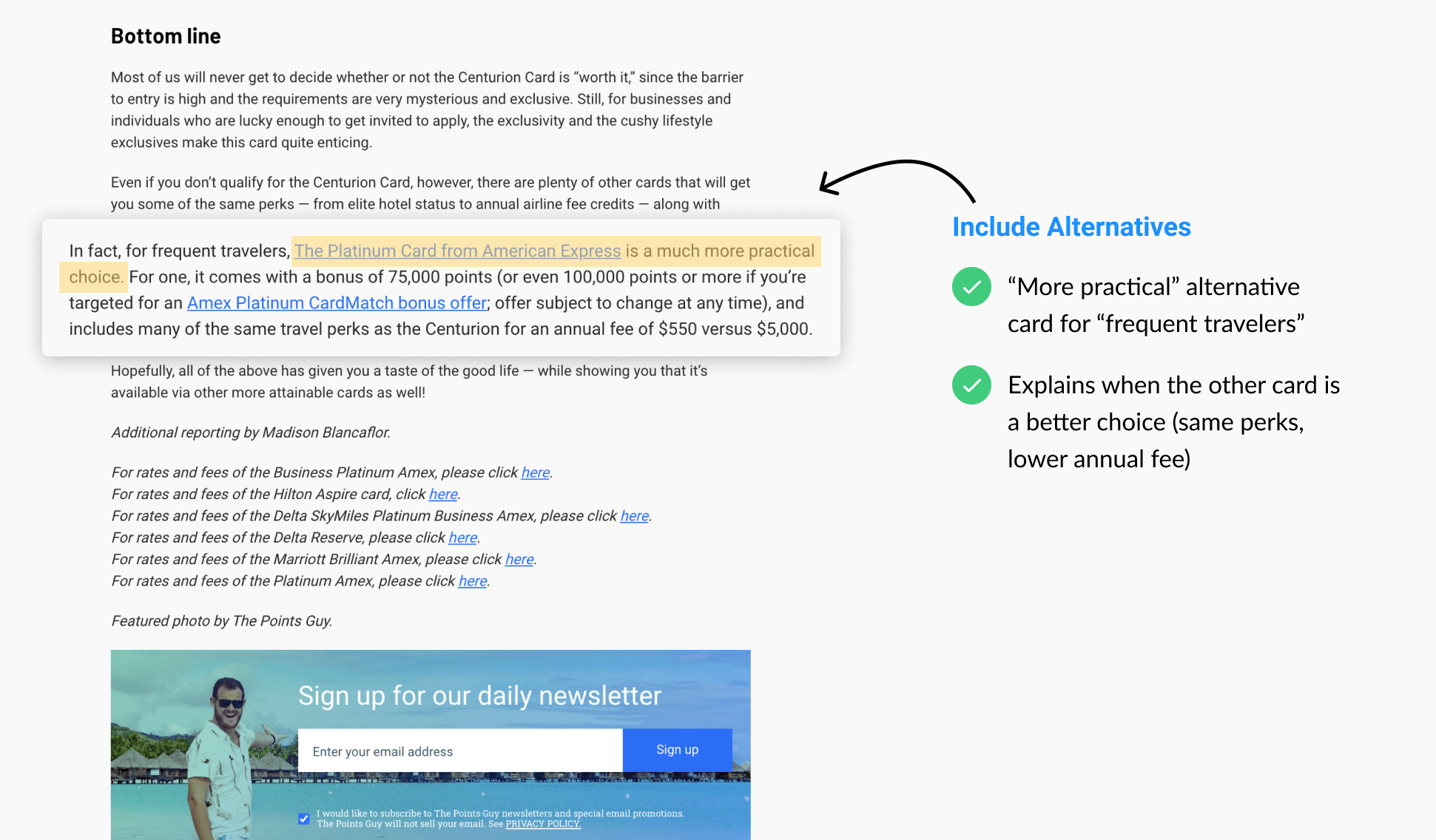
While conversions for Amex Black are probably incredibly lucrative, many readers just won't qualify or have the bandwidth to drop five grand on annual service charges. But there are other cards with similar benefits at 10% of the price.
You can offer multiple alternatives if it makes sense. Or end with a roundup of all the products mentioned in your review.
Again, this falls in line with Google's recommendation in their most recent Product Review update:
[Your review should] cover comparable products to consider, or explain which products might be best for certain uses or circumstances.
7. Conclude with a strong CTA
If you're genuinely a fan of the product, make the recommendation again. Reiterate why you like it. And list the best places to purchase the item online.
For the most part, very few readers will make it to this part of your article, but the others that do deserve a solid summary of everything they've just read.
Ready to apply some of these techniques?
Product reviews and product roundups are some of the best converting content you can spend your time on as a publisher, blogger, or affiliate marketer.
But getting it right doesn't have to come down to complete guesswork.
This product review template should give you a solid start at creating, iterating, and testing high-converting content. All based on what's working for the internet's leading publishers (and based on data).
If you want to go further, click here to try Affilimate free for 15 days and see if you can improve your conversion and earnings through our platform.
Til next time 👋

